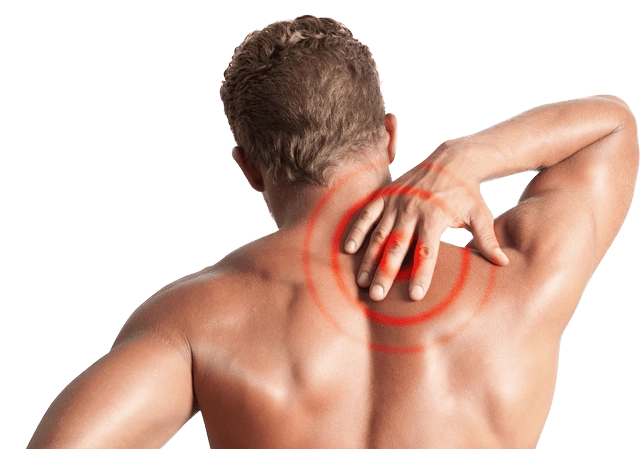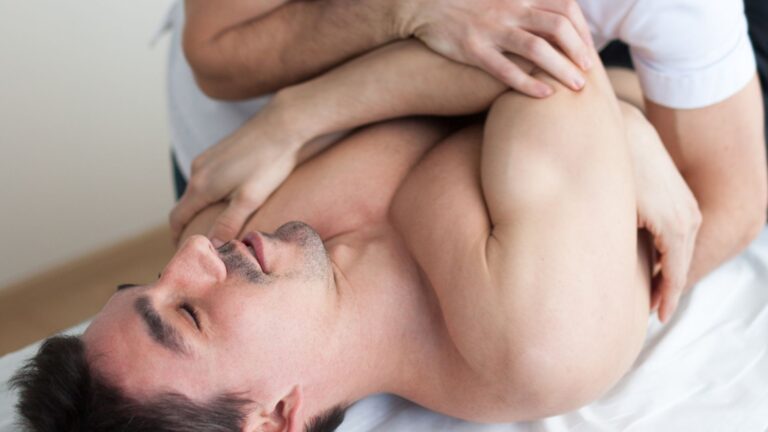Anchorage Chiropractor Explains: How Do You Treat a Pinched Nerve?
By Dr. Brent Wells, DC

A pinched nerve comes about when spinal disc ruptures and the jellylike substance from inside the disc exerts pressure on a nerve. Although the problem is in your neck, a pinched nerve frequently causes pain that shoots down into your arm. The pain may come on slowly or suddenly. But don’t worry. Your Anchorage chiropractor can help.
One form of a pinched nerve is a stinger. There are two types of stingers, the first one is called compression stinger and the other one is called distraction stingers. They both have a different feel.
Compression stingers are the result of compression of a nerve in the neck, so they fall into the category of a pinched nerve. The second type is caused by the distraction of a nerve.
The treatment of a pinched nerve usually involves cervical traction for two to six weeks. Physical therapy may also help to reduce the resulting muscle spasm. If symptoms do not go away, or the pain continues in your arms or your hands, surgery may be required.
Symptoms of Pinched Nerves
When you have nerve compression, you may experience painful symptoms. You may have other symptoms that have no pain, such that you cannot tell if you have a nerve problem.
Some common symptoms of compressed nerves include pain in the compressed area, radiated pain, radicular pain, tingling or numbness, weakness. These symptoms may be stronger with certain activities. They may bring a sensation of pins and needles or a burning sensation.
What Can You Do For A Pinched Nerve?
We recommend you to consult a doctor of chiropractic for an effective pinched nerve cure. Your body may be able to recover for a time, but you may need a professional chiropractor for pinched nerves to help with long-term recovery.
How to Treat a Pinched Nerve at Home
There are several things that you can do at home to alleviate pinched nerve pain. However, you must be able to recognize the condition and know how to distinguish the symptoms for you to be successful. Here are a few steps you should follow:
Step 1: Know the Problem
Remember that a pinched nerve can appear at any part of your body and may require professional chiropractic help.
Step 2: Know the Symptoms
You can easily diagnose and treat the problem if you can recognize the symptoms from the start. The aforementioned symptoms should help you know that you have a pinched nerve. Typically, the condition is associated with excruciating pains in the affected zone.
The symptoms will show due to the inability of your nerves to send signals properly. They are normally associated with obstruction or compression to your nerve.

Step 3: Do Not Exhaust Yourself
Do well to avoid overusing your body the moment you realize you have a pinched nerve. Make sure that the affected area is stress-free. If at all possible keep it from doing anything strenuous. If you continue using the tendons, joints, or muscles responsible for the problem, then you are likely to aggravate the situation.
Overusing the joints, tendons, or muscles may cause the surrounding area to swell and lead to more nerve constrictions. You can promote relief, which might not be instant, by avoiding flexing of the affected area. You will know which movement to avoid depending on the location of your pinched nerve. Pinched nerve pain will let you know where the nerves have become impinged.
Look out for carpal tunnel syndrome, which is normally caused by a pinched nerve. You can keep your wrist straight and avoid bending it when sleeping. This will offer relief from the nerve compression.
Step 4: Get Adequate Sleep and Proper Neck Placement
You are strongly advised to sleep well, and if possible, extra hours. This will allow your body enough time to heal itself. When your body gets the time it needs to rest and heal, the symptoms of the condition will subside.
However, you need to know how to sleep properly with a pinched nerve in order to avoid worsening the condition. If you have a nerve being pinched on your left side, you may experience radiated neck pain.
This means there is pressure on your left side. If your head is in a position where you are compressing more to the left, then the affected nerve is going to be more inflamed. To avoid hurting the affected area, you should consider sleeping on a higher pillow.
If your pillow is higher, your head will be upright, opening up the compressed area to your left. This will relieve the excess pressure from the nerve. Alternatively, you can sleep on the other side with a lower pillow, allowing the left side (affected area) to open up.
If you are experiencing pinched nerves, you cannot afford to sleep without a pillow. However, you must use your pillow correctly to avoid aggravating the condition. You can use almost any kind of pillow, as long as you position yourself correctly.
Step 5: Apply Heat and Ice
Most pinched nerve cases involve swelling, which may aggravate the condition. We encourage you to apply heat and ice on the affected region to help minimize the swelling and improve blood circulation.
Better results are achieved if you apply the ice and heat with respect to a given time interval. You can start with ice and then followed by heat. Apply ice for a period of fifteen minutes, three times a day to reduce the inflammation.
Then, apply heat to the pinched nerved for a period of one hour, four times a night to improve blood circulation. You should not exceed fifteen minutes when applying ice in order to avoid reduce blood flow, and you should not exceed one hour when applying heat so as not to worsen the inflammation.
Step 6: Get a Chiropractic Massage Therapy
Massage therapy is known to relieve the compression and help achieve pinched nerve relief. You may find great appreciation in a full body massage from a chiropractic massage therapist for improved recovery from pinched nerve pain.
Step 7: Eat Foods That Will Help Alleviate the Condition
If you have not tried this, then you should know that there are some foods that can help you deal with a pinched nerve. The most recommended types being dark green vegetables and bananas. Normally, lack of calcium and potassium may lead to the condition.
Foods rich in calcium are spinach, kale, seaweed, low-fat dairy, and sesame seeds. Foods rich in potassium include bananas, avocados, walnuts, and cashews.
Step 8: Maintain a Good Posture
Poor sitting positions can aggravate the condition. You can exercise good sitting posture by using a chair that is fixed with back support, sit upright, get more back support, and do not sit for extended durations. To achieve all the above, you can use a chair, a folded towel, and a footstool.
Step 9: See Your Anchorage Chiropractic Doctor When the Symptoms Do Not Subside
You might get temporary or lasting relief by using the abovementioned home treatment techniques. However, you should consult a chiropractic physician if the symptoms keep on returning and the pain fails to go away within a day or so.
Your Anchorage-based chiropractor can help develop a recovery plan that fits your specific pain condition. Knowing how to treat a pinched nerve is the next step in recovery.
Chiropractic Treatment for a Pinched Nerve in Anchorage
Pinched nerves may be caused by subluxations and other musculoskeletal and neuromuscular conditions. Many of the causes can be managed with spinal manipulation procedures.
Many chiropractic methods are focused on finding pinched nerves. By feeling the vertebrae and the surrounding muscles, your Anchorage-based chiropractor will work to detect affected parts. A joint that does not move as freely as it should is a clear sign of nerve impingement.
Chiropractic treatment is exceptionally helpful in curing a pinched nerve. This condition normally involves an impingement. Therefore, there must be a joint pressing on the affected nerve. This can include tight muscles, a herniated disc, or a bulging disc.
With a pinched nerve, you should expect the pain to radiate, since it does not always remain local. For instance, a pinched nerve in your lumbar area can radiate pain into your leg. A nerve in your neck can radiate pain into your arm.
A doctor of chiropractic can help you treat the condition by moving the bones into their correct positions in order to relax the muscles and eliminate the pressure exerted on nerves. You can receive treatment for a pinched nerve and any other associated symptoms without surgery.
A few techniques used are:
- Flexion-distraction technique
- Massage therapy
Flexion-distraction therapy
This is a treatment that alleviates neck and back pain caused by a pinched nerve, sciatica, and disc herniation. This method consists of a special table that features bending, extending, and flexing procedures, which enable the chiropractor to make the needed adjustments.
Most studies consider flexion-distraction to be a staple chiropractic solution, which does an amazing job of treating the patient’s vertebral column in order to promote pain relief. This method gives the doctor control of the spine during therapy.
Flexion-distraction technique is what most chiropractors will recommend for a pinched nerve and the associated ailments, including neck pain, leg pain, stenosis, headaches, arm pain, and whiplash.
Benefits of Flexion-Distraction Therapy
- Decreases annular tension exerted on annular nerves and fibers
- Increases the height of the intervertebral disc to increase circulation
- Ensures the nucleus pulpous recovers its central position within the fibers
- Gets rid of irritation in the spinal nerve
- Helps return the vertebral joints to their original healthy motion
- Relieves pain and improves posture and motion
Massage Therapy
Can a massage help a pinched nerve?
It is advisable to handle the problem while it is mild. This way, you can engage alternative treatment options, such as massage therapy. Your visit to a chiropractor may include massage therapy as one of the options. Treating pain conditions early helps to minimize the risk of chronic pain.
One good thing about massage therapy is that no surgery is involved. It offers pain relief and muscle relaxation further helping the body to promote its own recovery. Massage therapy helps to focus mainly on the pinched nerve area.
You can also prevent the development of a pinched nerve with the following:
- Infrared massaging devices: Uses infrared technology to reach the deep muscle tissues for quick results.
- Infrared heating pads: Uses infrared technology to take apart pinched nerves and promote blood flow.
- Cervical traction devices: Helps to readjust the cervical spine from the neck downwards.
From the points we have highlighted above, it is clear that massage therapy is a reliable alternative for treating and preventing the condition. Consulting a chiropractic massage therapist helps increase recovery efforts and improve results.
How Do You Get a Pinched Nerve?
When too much pressure is applied to a nerve a pinched nerve can occur. This is compression caused by the surrounding matter that causes the pinched nerve in a specific area of the body to become under pressure.
Pressure may come from nearby bones and cartilage, such as in the instance of a herniated vertebrae disc that compresses a nerve root. Tendons are also capable of causing pinched nerve pain.
In the case of carpal tunnel syndrome, a number of functions may be accountable for the tightening of the median nerve of the carpal tunnel, including thickened ligament, and swollen tendon sheaths in the tunnel.
There are a number of conditions that may cause tissue to tighten a nerve or nerves, including injury, rheumatoid or wrist arthritis, stress from repetitive work, hobbies or sports activities, and obesity.
If a nerve is pinched for only a short time, there is no permanent damage that is created. Once the pressure has been relieved, nerve function returns to its normal condition. But if the pressure continues, nerve damage may be difficult to heal. That’s why it’s better to see your Anchorage-based chiropractor sooner rather than later. So, reach out and schedule an appointment. We are here to help.

About the Author
Dr. Brent Wells has been a trusted chiropractor since moving his family from Oregon to Alaska back in 1998 and founded Better Health Alaska – B.S. from Univ. of Nevada, Doctorate from Western States Chiropractic College, volunteer for Reflex Sympathetic Dystrophy Foundation, and member of the American Chiropractic Association. As a chiropractor his focus is on family, including his 3 children and wife of 20+ years, his clinics, and ongoing education.
Related Posts
NEWSLETTER SIGN-UP
Sign up now!
South Anchorage
- 8840 Old Seward Hwy E, Anchorage, Alaska 99515
- Phone: 907-743-0110
- Open Hours: 9AM to 7PM













